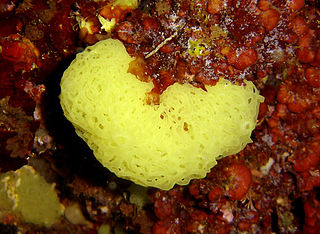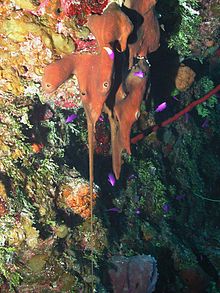
Clathrina is a genus of calcareous sponge in the family Clathrinidae. Several species formerly in Clathrina were transferred to the newly erected genera Arturia, Ernstia, Borojevia, and Brattegardia in 2013. The name is derived from the Latin word "clathratus" meaning "latticed".

Halichondria is a genus of sea sponges belonging to the family Halichondriidae. These are massive, amorphous sponges with clearly separated inner and outer skeletons consisting of bundles of spicules arranged in a seemingly random pattern.

Homosclerophorida is an order of marine sponges. It is the only order in the monotypic class Homoscleromorpha. The order is composed of two families: Plakinidae and Oscarellidae.

Plakinidae is a family of marine sponges. It is composed of seven genera:

Lyssacinosida is an order of glass sponges (Hexactinellida) belonging to the subclass Hexasterophora. These sponges can be recognized by their parenchymal spicules usually being unconnected, unlike in other sponges in the subclass where the spicules form a more or less tightly connected skeleton. Lyssacine sponges have existed since the Upper Ordovician, and three families are still alive today. The Venus' flower basket is one of the most well-known and culturally significant of the glass sponges.

Clathria is a large genus of demosponges in the family Microcionidae.

Tectitethya crypta is a species of demosponge belonging to the family Tethyidae. Its classified family is characterized by fourteen different known genera, one of them being Tectitethya. It is a massive, shallow-water sponge found in the Caribbean Sea. This sponge was first discovered by Werner Bergmann in 1945 and later classified by de Laubenfels in 1949. It is located in reef areas situated on softer substrates such as sand or mud. Oftentimes, it is covered in sand and algae. This results in an appearance that is cream colored/ gray colored; however, when the animal is washed free of its sediment coverings, its body plan appears more green and gray. It's characterized with ostia peaking out of its body cavity, with the ability to abruptly open or close, changing its desired water flow rate through its mesohyl.
Corticium diamantense is a species of sea sponge in the order Homosclerophorida, first found in vertical walls of reef caves at depths of about 23 to 28 metres in the Caribbean Sea. This species has oscula situated near its border; regular non-lophose calthrops of one size, rare tetralophose calthrops and candelabra, the fourth actine of which is basally ramified into 4 or 5 microspined rays.
Plakortis dariae is a species of sea sponge in the order Homosclerophorida, first found in vertical walls of reef caves at depths of about 23 to 28 metres in the Caribbean Sea. This species has diods of two different categories: it possesses large ones and small, rare, irregular, curved ones, which are often deformed with one of its ends being blunt ; triods are rare and regular.
Plakortis edwardsi is a species of sea sponge in the order Homosclerophorida, first found in vertical walls of reef caves at depths of about 23 to 28 metres in the Caribbean Sea. This species has diods of a single category, with thick and S-shaped centres ; triods which are T-shaped. It is the only species of this genus exhibiting small diods.
Plakortis myrae is a species of sea sponge in the order Homosclerophorida, first found in vertical walls of reef caves at depths of about 23 to 28 metres in the Caribbean Sea. This species has diods of two categories: large ones which are abundant, and rare small ones with S-shaped centres; triods which are Y- or T-shaped, and possesses abundant microrhabds.
Plakina nathaliae is a species of sea sponge in the order Homosclerophorida, first found in vertical walls of reef caves at depths of about 23 to 28 metres in the Caribbean Sea. It has a leaf-like flat body, which is loosely attached to the substrate and a perforated, unlobate surface; it contains two bacterial morphotypes and is characterized by two mesohylar cell types with inclusions.

Geodia barretti is a massive deep-sea sponge species found in the boreal waters of the North Atlantic Ocean, and is fairly common on the coasts of Norway and Sweden. It is a dominant species in boreal sponge grounds. Supported by morphology and molecular data, this species is classified in the family Geodiidae.

Anheteromeyenia is a genus of freshwater sponge. It has been recorded in the Nearctic, the Neotropics. This taxon was initially a subgenus of Heteromeyenia when K. Schöder circumscribed it in 1927, but W. M. de Laubenfels made it a genus in its own right in 1936.

Mycale is a genus of demosponge with 240 recognised species in 11 subgenera. It has been a large genus with multiple subdivisions since it was first described in 1867.
Dysidea etheria, commonly known as the ethereal sponge or heavenly sponge, is a species of lobate sponge within the class Demospongiae. This marine sponge is known for its light blue color and can be found in the Caribbean as well as off the coasts of Florida and Georgia. Like all other poriferans, D. etheria is capable of both sexual and asexual reproduction. The use of spicule collection as well as chemical defenses allows D. etheria to protect itself against predators such as the zebra doris and the orange knobby star. D. etheria is also known as a host species of the invasive brittle star Ophiothela mirabilis. Lastly, various molecular biology studies have utilized D. etheria to both study foreign particle transport in sponges and to isolate novel molecules.
Michelle Kelly, also known as Michelle Kelly-Borges, is a New Zealand scientist who specialises in sponges, their chemistry, their evolution, taxonomy, systematics, and ecology.

Robertus Wilhelmus Maria (Rob) van Soest, born in 1946, is a Dutch marine biologist. He works at the Naturalis Biodiversity Center and is also affiliated with the University of Amsterdam. He co-authored with John N. A. Hooper Systema Porifera: A Guide to the Classification of Sponges, a standard reference for sponge classification.

Monanchora is a genus of demosponges belonging to the family Crambeida. The genus contains 18 species, which have been researched for their potential use in medicine.

Oscarella is a genus of marine sponges. The genus can be found off the coast of every continent, in every ocean except the Arctic.













